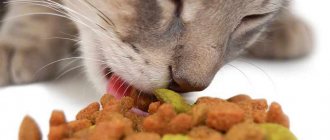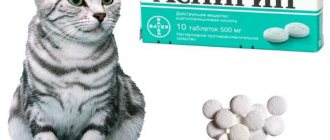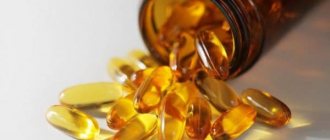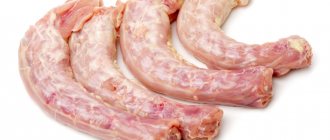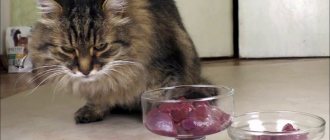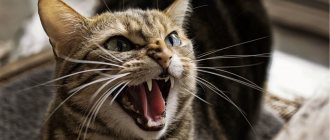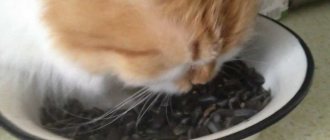Is it possible to feed a cat potatoes?
If a cat eats potatoes or gnaws on raw tubers, this indicates a lack of potassium, vitamins C and E, as well as other useful substances in the animal’s body. But you should not abuse this product, especially when preparing a diet for kittens. In such situations, it is better to consult with a veterinarian, who will tell you what vitamins and supplements should be included in your pet’s menu.
Benefits and harms
Adding potatoes to a kitten's diet has both positive and negative sides. The advantages of such nutrition include the fact that the vitamins contained in the vegetable have the following effects on the body:
- improve visual functions;
- make the coat thick;
- improve immunity and nervous system;
- normalize metabolism;
- accelerate wound healing.
Useful substances such as copper and potassium are necessary for building bone tissue and muscles and maintaining the functioning of the heart. Fiber is an essential component for normal digestion. During diarrhea, it removes fluid and helps remove hairballs that form in the gastrointestinal tract of cats. The benefits of potatoes are also evidenced by the fact that many feeds contain this product. The downside of kittens eating root vegetables is the high starch content in the product. This component clogs the intestines, is very poorly digested or not digested at all, which leads to indigestion and flatulence.
Can it be given to cats?
Raw potatoes
If a kitten steals and chews the peelings of a tuber, then you should contact a specialist and try to wean him off this delicacy. Most veterinarians prohibit giving raw potatoes to your pets. The reason is solanine contained in the vegetable, which is considered quite poisonous. Such feeding can cause not only harm to the kitten in the form of poisoning, but also lead to death. Another reason is the high starch content, which makes it difficult for the digestive system to function. Therefore, cats should not eat raw potatoes.
Boiled potatoes
The prepared root vegetable is completely safe for pets. During heat treatment, solanine is completely destroyed. When introducing potatoes into an animal’s menu, you should follow some rules:
- You should only give your kitten boiled or baked potatoes.
- It is better to take new potatoes with a low starch content.
- You cannot cook sprouted tubers.
- The old vegetable should be thoroughly cleaned and soaked in cold water.
- You need to cook without salt and other spices.
Related article: Chicken droppings as fertilizer and food for potatoes
The amount of starch in a boiled or baked vegetable is within the acceptable limit, so it will not harm the cat. However, it is important to ensure that bloating, constipation or diarrhea does not occur.
Veterinarians often do not recommend feeding your pet potatoes. The acceptable norm is ¼ of an average root vegetable once a week. Kittens eat mashed potatoes with great pleasure. It can be mixed with meat or fish, 1-2 tsp. weekly. The restriction on the amount of root vegetables consumed is due to the large amount of carbohydrates it contains. It is known that such abuse can lead to obesity in a cat. It is also not recommended to frequently feed your animal lentils and other legumes.
How to keep vegetables safe
The concentration of harmful substances is reduced in the following ways:
- The animal is fed with seasonal vegetables: less fertilizer is used during cultivation. In winter it is better to use frozen ones.
- Food is kept in the refrigerator: in a warm environment, nitrates quickly turn into nitrites.
- Fruits and greens are thoroughly rinsed: water washes away dirt, harmful microorganisms, and chemicals from the surface.
- The peel, stalks, and tails are cut off, the top leaves are removed from the salad, the stems are removed from parsley and dill: in these parts the level of nitrates is higher. In carrots they are concentrated in the core.
- Greens and peeled fruits are kept in water for half an hour, toxic substances pass into the liquid.
- When cooking, the amount of nitrates is reduced by 50–80%, the poisonous solanine in potatoes, tomatoes, and eggplants is destroyed.
- Heat treatment will not help neutralize the toxic effects of disulfides in onions, garlic, and persin in avocado peels. These vegetables are excluded from the diet.
We invite you to familiarize yourself with: Carrying bag for a cat - easy with your own hands
A relative of the king of beasts should not eat sausages
Cats are close relatives of lions. The basis of the diet of the king of beasts is the animal protein of the caught prey and all the components of its stomach. Cats' prey is much more modest, but they are still a small predator. In the wild, cats feed on small mammals (catching mice), attack birds, lizards and frogs, and feast on fish.
By eating whole prey, cats receive all the necessary nutrients, including vitamins and minerals. The diet of domestic cats should not differ from the diet of cats living in the wild. Therefore, food from the master's table, such as fried fish, potatoes or sausages, is not suitable for a domestic carnivore.
In order to create a diet for an animal that will not cause health problems, you need to have knowledge of the basic physiology of nutrition. It is this knowledge that we will share with you in our article.
Natural nutrition: pros and cons
Every cat needs a balanced diet consisting of foods rich in proteins, carbohydrates, fats, vitamins and minerals. The pet can get them from natural products prepared by the owner himself.
The advantage of feeding your cat natural food is that you will know what products are included in your pet’s diet. And definitely don’t allow any “chemistry” in there. In addition, industrial food looks unnatural and unusual for humans. Therefore, owners often have doubts about the benefits and safety of this type of feeding.
The disadvantage of using natural products to feed a cat is that ready-made meals quickly spoil and require knowledge, skills and time to prepare.
If you decide to become a nutritionist for your cat and learn the basics of cooking for animals, read our article below.
Treasured BZHU: feeding cats with natural food
There are no uniform rules for creating a cat’s diet. It all depends on the individual characteristics of the animal. Some cats like variety in their food, others prefer one or two types of food. If the pet doesn’t like the food, he will starve until the owner takes his preferences into account.
When preparing a natural diet, some owners include exclusively meat foods. Remember that tailed predators need nutrients, vitamins, micro- and macroelements found in plant foods. The lack of these substances is reflected in the appearance of the pet: the cat’s fur begins to fall out, become tangled, and dandruff appears.
Related article: Should I pluck potato sprouts before planting?
In order for a cat’s diet to be balanced, it must include high-quality foods containing proteins, fats, carbohydrates, vitamins and minerals. We’ll talk about the main sources of nutrients in a cat’s diet separately.
Cooked potatoes
Veterinarians urge cat owners to remember that the best option is to include cooked potatoes in moderate doses in the diet. The optimal norm is 1-2 spoons per week, but you should follow some simple rules:
- Young boiled or baked potatoes contain a minimal amount of starch, so they are ideal for feeding animals.
- You should not flavor the dish with salt or seasonings, because this can lead to the development of urolithiasis in animals.
- Old potatoes must be peeled, soaked in water and cut into small pieces or crushed until smooth, after which they can be mixed with canned meat.
- Tubers that have turned green or have sprouts should never be given to an animal, because they contain solanine, which is poisonous for cats.
- You should not mix potatoes with balanced dry food, because this will upset the animal’s nutritional balance, and in addition, the additive will reduce the smell of the food granules, making them uninteresting to a predator accustomed to relying on its sense of smell.
Protein sources
The bulk of your cat's diet should be protein. They are necessary for the growth and normal functioning of the body. Proteins consist of amino acids, some of which are not produced in the pet’s body and must be supplied in sufficient quantities with food.
Protein sources for cats:
- Meat and meat products;
- Fish;
- Dairy products;
- Eggs.
Feed your pet lean beef. You can also give your animal lamb, rabbit, chicken and turkey.
By-products are an integral part of any cat’s diet, as they have high biological value. For example, the liver contains a lot of vitamin A, fatty acids and microelements.
Of the by-products, the cat is given beef or chicken:
- Liver;
- Kidneys;
- Heart frozen, raw or boiled.
Include fish in your cat's diet: river or sea. It should be given no more than 1-2 times a week. Fish is in no way inferior to meat in terms of biological value, but it contains a large amount of mineral salts, which settle in the form of crystals in the kidneys and ureters. Also, too frequent consumption of raw sea fish leads to a lack of B vitamins in the cat’s body.
Sea fish is given to your pet boiled, and large bones are removed from it. River fish is also fed boiled, since it is often infected with helminth larvae.
Eggs contain all the necessary microelements, but do not give them to your cat more than once a week. Raw egg whites are completely excluded from the pet’s diet, as they negatively affect the normal molting process and cause dermatitis. You can give boiled egg white to your cat occasionally by chopping it with a knife. Many pets like omelettes prepared with milk or water. The yolk is given to the cat both boiled and raw. It is added to porridges or offered separately.
Dairy products are an important component of a cat's diet. We recommend giving milk in its pure form only to kittens, since most adult cats do not digest it and cause digestive problems. You can give fermented milk products with reduced fat content:
Include these products in the diet of an adult cat 1-2 times a week.
Raw or cooked
The opinions of felinologists and veterinarians differ, but there are no strict prohibitions regarding either fresh or boiled vegetables. Cats are reluctant to eat them, so owners often follow the pet’s taste and give them in the form that he likes. Be sure to cook food for animals with diseases of the gastrointestinal tract.
The need for treatment for healthy cats depends on the stiffness of the fibers:
- beets, cabbage, and pumpkin are boiled to soften coarse fiber and reduce the concentration of nitrates;
- tomatoes, potatoes, eggplants are processed to remove solanine;
- greens and cucumbers are given raw;
- zucchini, green beans, and carrots are fed fresh and boiled.
Plant food is a secondary but necessary component of a cat’s diet. They are taught to eat them from childhood, they are given vegetables that the pet eats, except toxic ones, and they are prepared correctly.
Pros and cons of potatoes in a cat's diet
Experts do not have a consensus on whether to give cats boiled mashed potatoes or not. Some consider raw potatoes to be poison for pets, while others, on the contrary, believe that potatoes contain enough nutrients that are beneficial for cats and are healthy. In principle, a large number of pets that lived to an old age ate potatoes.
Related article: Can nursing mothers eat potatoes: boiled, fried, stewed?
So where is the truth? But the truth lies in the golden mean. This product contains both beneficial and harmful substances for cats; let’s take a closer look at this information.
Optimal diet for a cat
When considering the issue of cat nutrition, you should also pay attention to the fact that village cats, which often obtain their own food on their own, in addition to their direct prey - rats and mice, automatically eat food that was in the crops and stomachs of the victims - here we are talking about plant matter. components, including broccoli, potatoes and many other vegetables.
So here it is. Being on such a natural diet, village cats and dogs practically do not get sick, they do not experience such a phenomenon as indigestion. The cat’s stomach itself is perfectly adapted to digesting both animal and plant proteins. Following this, a balanced diet for a domestic cat should have the following percentage :
- 70–75% meat
- 15–20% vegetable additives
- 10% cereals
The only thing that should be taken into account is that in the diet of sedentary or sterilized animals, the protein and fat content must be reduced by 5-10%.
Video response
Dr. Shu: YOU CAN! Beets are very useful. But it must be given in very small quantities. For such a small kitten, no more than half a teaspoon a day. Otherwise there will be diarrhea.
Natalya Artemenko: There is no need - the kitten will benefit from it to zero, and besides, beets weaken. If you want to remove burgundy diarrhea, take a risk)))
We suggest you read: Scabs on the neck and head of cats
Olga Bezrukova: No, you can’t have beets! Read how to feed cats Harsh: you have nothing else to feed? Cats are not people, they have their own diet.
This video will help you figure it out
Verritta: Of course it can. Beets are one hell of a dye. How do you manage to feed your cat beets and carrots? You are just some kind of genius! Teach me, will you?
RED RED: Maybe.
Nastya Petruchenya: Of course)
Ivanov Oleg: maybe the same as in humans
Maria Bizyukova: beets can cause your cat's fur to darken... The coloring substances in beets, of course, also lead to staining of urine... I wouldn't give...
Fork: Of course it can!
Katjunka:my bald little guy eats beets and also pees red-pink.)
Yulia Ivanycheva: Of course it can.
Kler: Of course it can, but it makes sense to stop giving beets for a while to make sure that it’s definitely not ICD.
Elena the Beautiful: Maybe, of course! Aren’t you afraid that from such feeding (beets and carrots) the cat will say “me-e-e-e” instead of “meow”?
